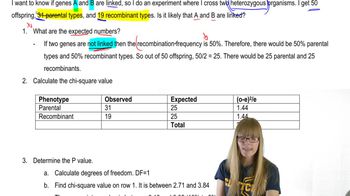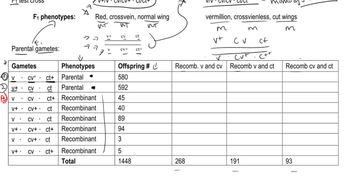Table of contents
- 1. Introduction to Genetics51m
- 2. Mendel's Laws of Inheritance3h 37m
- 3. Extensions to Mendelian Inheritance2h 41m
- 4. Genetic Mapping and Linkage2h 28m
- 5. Genetics of Bacteria and Viruses1h 21m
- 6. Chromosomal Variation1h 48m
- 7. DNA and Chromosome Structure56m
- 8. DNA Replication1h 10m
- 9. Mitosis and Meiosis1h 34m
- 10. Transcription1h 0m
- 11. Translation58m
- 12. Gene Regulation in Prokaryotes1h 19m
- 13. Gene Regulation in Eukaryotes44m
- 14. Genetic Control of Development44m
- 15. Genomes and Genomics1h 50m
- 16. Transposable Elements47m
- 17. Mutation, Repair, and Recombination1h 6m
- 18. Molecular Genetic Tools19m
- 19. Cancer Genetics29m
- 20. Quantitative Genetics1h 26m
- 21. Population Genetics50m
- 22. Evolutionary Genetics29m
2. Mendel's Laws of Inheritance
Sex-Linked Genes
Problem 24b
Textbook Question
In a species of fish, a black spot on the dorsal fin is observed in males and females. A fish breeder carries out a pair of reciprocal crosses and observes the following results.
Cross I Parents: black-spot male x nonspotted female
Progeny: 22 black-spot male
24 black-spot females
25 nonspotted males
21 nonspotted females
Cross II Parents: nonspotted male x black-spot female
Progeny: 45 black-spot males
53 nonspotted females
Why does this evidence support the hypothesis that a black spot is sex linked?
 Verified step by step guidance
Verified step by step guidance1
Identify the pattern of inheritance by analyzing the progeny from both crosses.
In Cross I, observe that both black-spot and nonspotted males and females are produced, suggesting that the trait is not simply autosomal dominant or recessive.
In Cross II, note that all males have black spots while all females are nonspotted, indicating a potential sex-linked pattern.
Consider the possibility of the black spot trait being linked to the sex chromosomes, specifically the X chromosome, since the trait appears to be passed from the mother to the son in Cross II.
Conclude that the evidence supports the hypothesis of sex linkage because the trait's expression differs between the sexes and is consistent with X-linked inheritance patterns.
Recommended similar problem, with video answer:
 Verified Solution
Verified SolutionThis video solution was recommended by our tutors as helpful for the problem above
Video duration:
2mPlay a video:
Was this helpful?
Key Concepts
Here are the essential concepts you must grasp in order to answer the question correctly.
Sex Linkage
Sex linkage refers to the association of a gene with a sex chromosome, which can lead to traits being expressed differently in males and females. In many species, including fish, genes located on the X or Y chromosomes can result in sex-specific phenotypes. Understanding sex linkage is crucial for interpreting inheritance patterns, especially when analyzing traits that appear to be influenced by the sex of the organism.
Recommended video:
Guided course

Chi Square and Linkage
Reciprocal Crosses
Reciprocal crosses involve mating individuals in both possible combinations to determine the inheritance of traits. By crossing a black-spot male with a nonspotted female and vice versa, the breeder can observe how the trait is passed on through generations. This method helps clarify whether a trait is dominant, recessive, or linked to sex chromosomes, providing essential data for genetic analysis.
Recommended video:
Guided course

Trihybrid Cross
Phenotypic Ratios
Phenotypic ratios represent the relative frequencies of different observable traits in the offspring of a genetic cross. In this case, the ratios of black-spot to nonspotted fish in the progeny can indicate whether the black spot trait is inherited in a manner consistent with sex linkage. Analyzing these ratios helps in understanding the genetic basis of traits and supports or refutes hypotheses about inheritance patterns.
Recommended video:
Guided course

Mutations and Phenotypes

 7:56m
7:56mWatch next
Master Sex-Linked Genes with a bite sized video explanation from Kylia Goodner
Start learningRelated Videos
Related Practice



